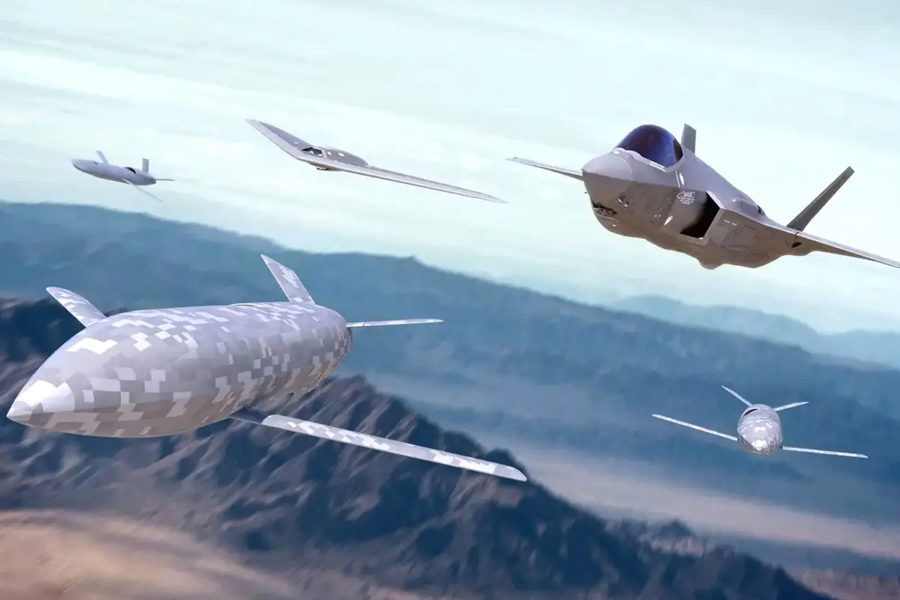While collaborative combat aircraft are among Air Force Secretary Frank Kendall’s “operational imperatives,” Air Combat Command was already working on the idea, the Air Force reported.
Kendall “has been providing direction for Collaborative Combat Aircraft” to ACC through the operational imperatives, but Headquarters, Air Force, and ACC “were already in the process of identifying a path to realize CCA capability” when Kendall set the concept among the list of OIs, a USAF spokesperson said.
Senior USAF leaders at AFA’s Air, Space & Cyber Conference in September said they were looking for a swift pace of experimentation, prototyping, and production of CCAs—in as few as two years—but the concept is still far from defined as to what missions the uncrewed aircraft will perform, how sophisticated they need to be, and how they will take direction from and interact with the human pilots in their formations. Kendall has broadly suggested that as many as “four or five” CCAs could accompany a single crewed aircraft. He sees CCAs as an affordable way to expand USAF capacity and to compel an enemy to expend many munitions to disable an attacking USAF formation.
Asked whether the CCA requirement is being handed down to ACC from USAF leaders, or whether there is a “pull” requirement from ACC, Air Force acquisition executive Andrew Hunter said at the conference, “That’s a good question.”
He continued that the requirements community “was an integral part” of creating the OIs: “So I would say that, as far as I can tell, we have very strong buy-in from the requirements community [and] from ACC” as to the need for, and utility of, CCAs. But he could not say exactly how the requirement was generated or where it stood in the requirements process.
The spokesperson said Headquarters, Air Force, and ACC “are now working with industry to further develop requirement documents.”
The issue is not trivial, as USAF leaders have for years lamented that promising new concepts or technologies, developed in the labs and potentially even used in live experiments and exercises, sometimes fail to transition to programs of record without a “pull” requirement from a user command, which may not even know the technology exists. This gap between concept and program of record is often referred to as “the valley of death.”
Hunter, at the AFA conference, said USAF leaders remain “engaged continuously” with user commands.
He noted, too, some “cultural resistance” to the idea of CCAs, saying this is to be expected because “change is hard.” But he also said CCAs have top-down support from Kendall, Chief of Staff Gen. Charles Q. Brown Jr., and ACC commander Gen. Mark D. Kelly.
The Mitchell Institute for Aerospace Studies formally released a paper Oct. 13, “Five Imperatives for Developing Collaborative Combat Aircraft for Teaming Operations,” which urges the Pentagon to get operators involved with developing the nascent technology, to ensure that it is combat-relevant and user-friendly. The paper had previously been briefed to reporters.
The paper recommends that, before rushing to field CCAs, the Air Force first develop a concept of operations as well as tactics, techniques, and procedures for their use, with heavy pilot and operator input. The technology will have no value unless pilots feel they know what CCAs will do and can trust them to do it, paper author Heather Penney said.
She also noted that the Air Force has work to do to ensure resilient communications with CCAs in contested and denied airspace; and to develop procedures for what CCAs will do in a “comms out” situation. Finally, the Mitchell paper recommends the Air Force ensure that adding CCAs to combat formations doesn’t unduly burden pilots with additional work that might be unmanageable.
“There is a risk … of task saturation” unless this is taken into account early, with the development of software and the human-machine interface, Penney said on a streaming event.
Although Penney warns that the Air Force’s fighter pilot shortage will make it challenging to find ones able to help in CCA development, Maj. Gen. Charles S. Corcoran, assistant deputy chief of staff for operations, said development teams should instead “set up shop … in squadrons” so they can learn the environment pilots operate in firsthand and gradually insert CCAs into exercises, the better to familiarize pilots with what they can do and to tweak those capabilities to be “truly useful.”
